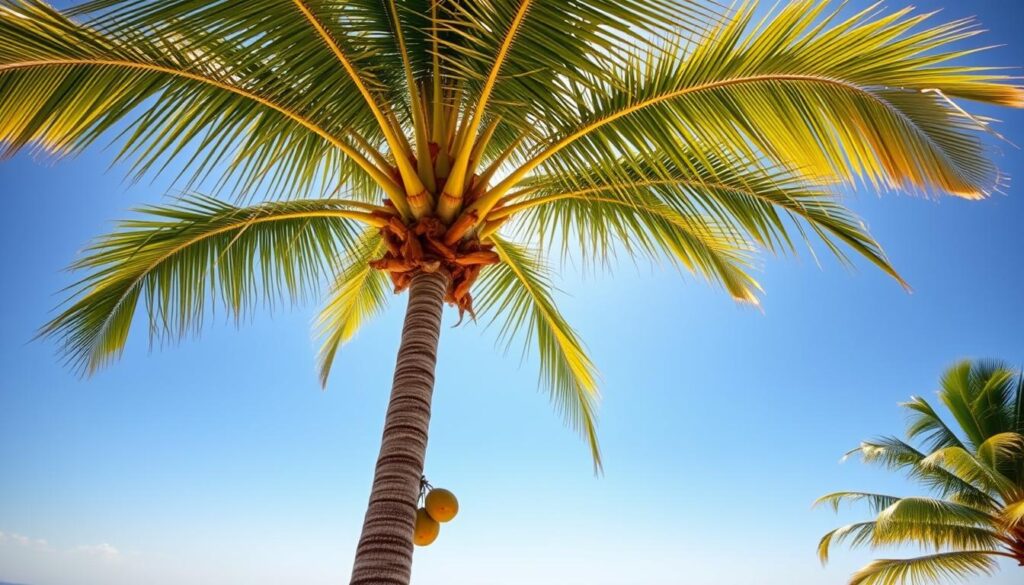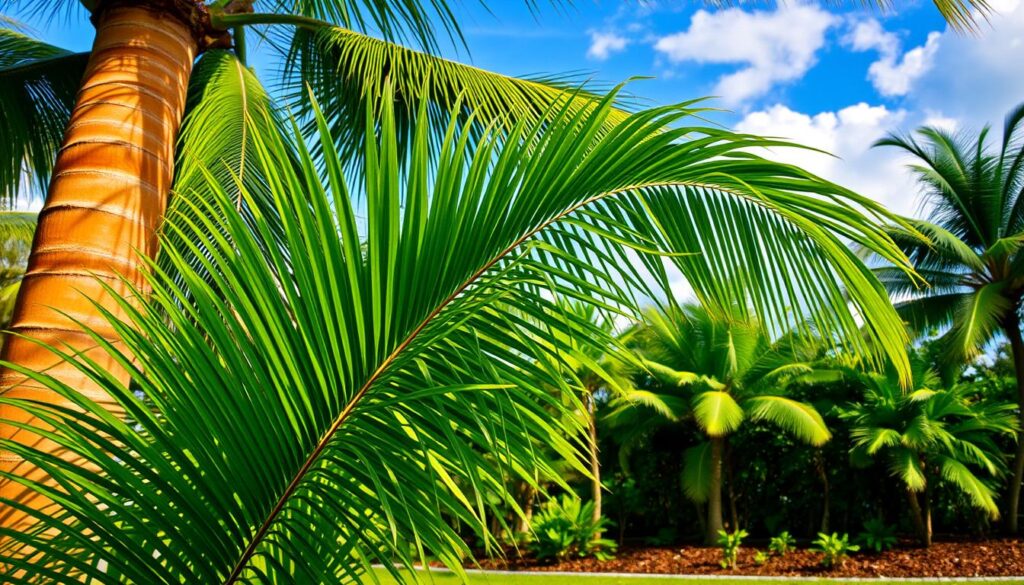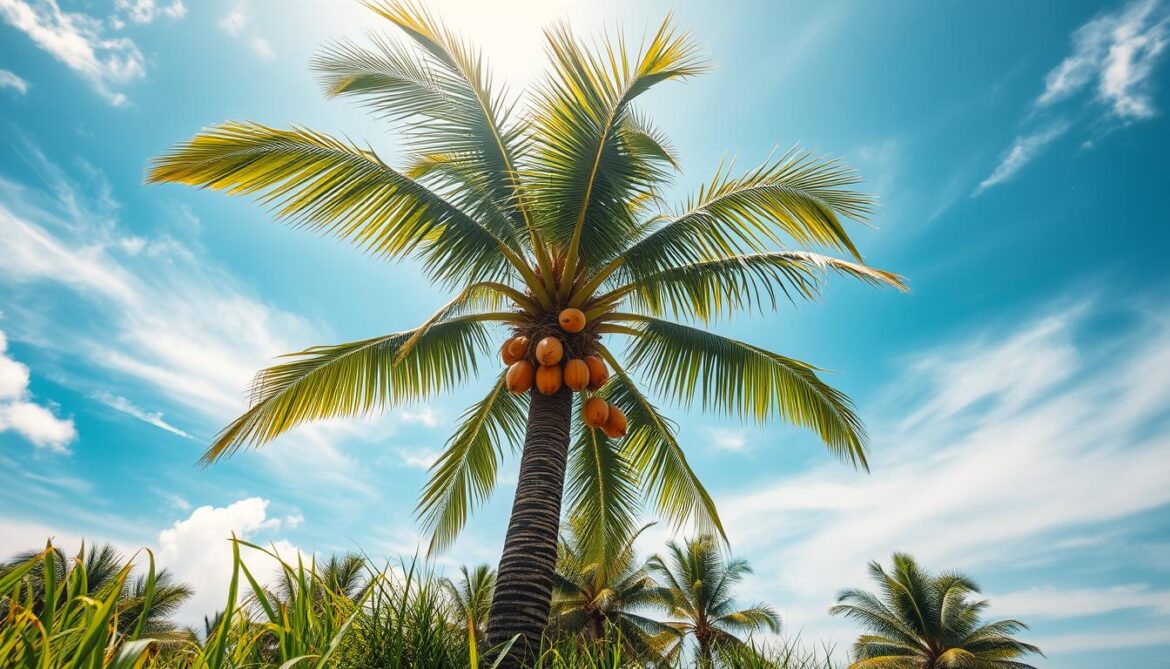I still remember the first time I peeled a fresh nut beneath a warm, salt-scented sky. The simple act of cracking that shell felt like unlocking a small, perfect world of flavor and purpose. That memory fuels this guide.
Here you’ll find clear, practical steps for planting and caring for a coconut palm that suits coastal and tropical-like climates in the U.S. We explain where the species thrives and why it is often called a “tree life” resource in island communities.
The guide covers soil, sun, watering, common problems, and harvest timing. It also shows how every part of the palm adds value — food, fiber, shelter, and more — while balancing the plant’s aesthetic beauty with real maintenance needs.
Key Takeaways
- The coconut tree is highly versatile and prized across the tropics for food and materials.
- This guide outlines planting, climate fit, care routines, and harvest timing.
- Understand species needs before planting to match local microclimates in the U.S.
- Every part of the coconut and palm provides practical value for homesteads and yards.
- Balance aesthetic goals with safety, space, and long-term maintenance planning.
Cocos nucifera at a Glance: Why the Coconut Palm Is Called the Tree of Life
Cocos nucifera stands out as a versatile coastal palm that shaped livelihoods across the tropics.
Naming and taxonomy: In horticulture the terms coconut palm, coconut palms, and palm trees often point to the same botanical entity, with regional usage deciding the exact way people refer to it. The accepted scientific name is Cocos nucifera, a species valued among tropical trees for its multiple uses.
Origin and global range
Evidence points to an origin near the Indian Ocean coast of southern Asia. Seafaring peoples deliberately spread the plant through Oceania, and Europeans later introduced it to the Caribbean in the 1600s, expanding its world range across Pacific, Indian, and Atlantic basins.
Why “life”? Every part of this palm supports food, shelter, tools, and trade. The sterile liquid inside young fruits supplied safe hydration and electrolytes on long voyages, which helped people settle remote islands.
“A single palm can feed, shelter, and supply a family — a living toolkit for coastal life.”
| Aspect | Detail | Why it matters |
|---|---|---|
| Taxonomy | Cocos nucifera | Accepted botanical name; central among tropical species |
| Origin | Indian Ocean / southern Asia | Explains coastal adaptation and genetic spread |
| Global range | Pacific, Indian, Atlantic tropics | Shows where cultivation and wild stands thrive |
| Key trait | Sterile liquid in fruit | Hydration source for sailors and islanders |
- Note: “palm trees” covers many genera; “coconut trees” and “coconut palm” usually mean Cocos nucifera.
- Climatic thread: it prospers near warm seas and humid coastal belts, guiding where home growers can succeed.
Climate, Sun, Soil, and Site: Can a Coconut Palm Thrive Where You Live?
Heat, humidity, and good drainage form the simple climate recipe this palm needs to prosper.

Temperature, sunlight, and humidity sweet spot
Thermal sweet spot: aim for roughly 85–95°F (27 ±5°C) with steady humidity. These conditions match coastal parts of the tropics and support fast growth and fruiting.
Provide at least six hours of direct sunlight daily. Young plants need bright, consistent exposure to set a strong canopy.
Soils, drainage, and water
Use well-draining sandy-loamy soils. The species tolerates pH from 5.0 to 8.0 but shows best vigor near 6.4–7.0.
Avoid waterlogged sites. If your garden holds rain, raise beds or mounds and use drip irrigation over a free-draining substrate to keep roots moist but not saturated.
United States feasibility and site tips
In the U.S., the best range is coastal Florida and Hawaii plus sheltered, frost-free microclimates along the Gulf. Windswept coasts suit the palm, but cold bursts harm canopy health.
- Create microclimates near warm masonry or south-facing reflective walls in marginal areas.
- Use wind breaks to protect young specimens from cold gusts.
- Remember: many palms tolerate chill differently; this palm needs sustained warmth to thrive.
| Factor | Ideal | Action |
|---|---|---|
| Temperature | 85–95°F | Plant in maritime warm zones |
| Sun | 6+ hours/day | Site in full sun |
| Soil/drainage | Sandy-loamy, pH 6.4–7.0 | Use raised beds if needed |
Coconut Tree Planting and Propagation
Begin with a sound selection: a heavy, unbroken husk and an audible slosh. Pick a fresh, husk-on nut and shake it. A clear slosh means the seed still holds moisture and vigor.
Selecting viable nuts
Choose heavy coconuts with intact husks and no cracks in the shell. Weight plus the slosh test is the quickest way to spot a viable seed.
Germination methods
Two common ways work well: float in a container (pointed end up) or plant directly in loose soil (pointed end down). The float method lets you monitor progress; direct-soil mimics natural beach germination.
Expect 3–6 months for a sprout and anchoring roots. Patience matters; early growth is slow but steady.
Transplanting, depth, and layout
When moving seedlings, nestle the shell so it sits partially exposed or just below the surface. Use coarse, well-draining soils or raised beds if your garden holds water.
Place young palms in full sun and consider staking in windy spots. Space multiple starts at least 5 meters (~16 ft) apart to avoid canopy crowding as plants mature.
- Keep soil moist but not waterlogged; soak deeply and let the surface dry between waterings.
- Maintain clean tools, mulch rings, and weed-free basins to reduce stress during establishment.
| Task | Detail | Why it matters |
|---|---|---|
| Selection | Husk-on, heavy, slosh test | Ensures internal moisture for germination |
| Orientation | Float: pointed up; direct: pointed down | Mimics natural sprout direction |
| Spacing | ~5 m (16 ft) | Prevents canopy overlap and root competition |
Care, Troubleshooting, Harvest, and Uses: From Seedling to Fruit and Beyond
Simple routines keep roots healthy and fruits developing on a healthy palm.
Watering and irrigation
Keep soil moist but never waterlogged. Young plants need steady moisture; mature, fruiting specimens may use 15–30 gallons daily in hot spells.
Ornamental palms often do well with about 1 inch of water weekly during the first year. Mulch basins to conserve moisture and protect roots.
Feeding and pruning
Fertilize every 2–3 months with a palm formula rich in potassium, magnesium, and iron to prevent yellowing and boost fruit set.
Prune only yellow or brown fronds. Leave green foliage to capture sunlight and fuel growth.
Pests, disease, and harvest
Watch for chlorosis and root rot in poorly drained sites. Improve drainage and use organic controls before chemicals.
“A brown husk and a soft internal slosh signal harvest time; pick with a pole and never linger beneath heavy fruit.”

| Need | Action | Why it matters |
|---|---|---|
| Irrigation | 1″ weekly (established); 15–30 gal/day when fruiting | Prevents drought stress and avoids root rot |
| Nutrition | Palm fertilizer every 2–3 months (K, Mg, Fe) | Supports canopy health and fruit production |
| Pruning/Harvest | Remove brown fronds; harvest when husk browns | Safety, photosynthesis, and quality fruit |
Beyond food, every part has value: the liquid inside is a sterile, electrolyte-rich drink; flesh and oil feed and heal; husk, fronds, shell, and trunk become fiber, thatch, bowls, and beams.
Conclusion
Wrapping up: place this palm where warmth, humidity, well-draining sandy soil, and full sun come together. Good site choice is the single best investment for long-term success.
For U.S. growers, coastal Florida, Hawaii, and frost-free pockets offer the best odds. Plant with care, give steady water and palm-specific nutrients, and protect young specimens from cold gusts.
One healthy coconut tree delivers fruit, hydration, fiber, shade, and building materials. Growing cocos nucifera links home gardening with traditional skills and local food resilience.
Start with a viable nut, be patient in germination, and tend the plant through maturity. With attentive stewardship, a coconut palm can reward you for decades — to the very end of its productive life.

